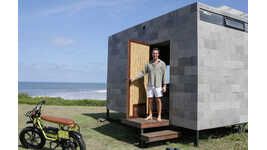A group of students from Hoboken, New Jersey designed a durable beach house that can withstand the force of powerful storms. After Hurricane Sandy devastated much of New Jersey in 2012, the state sought to work on constructing more resilient buildings. The 'Sure House' can not only withstand powerful hurricanes, but it can even supply emergency power to neighboring homes.
The students worked in conjunction with Stevens Institute of Technology to come up with the design for the durable beach house. The flood-proof home is armored against extreme weather and features windows made from three layers of 600 pound glass. The home itself is ultra-low energy and uses 90 percent less electricity than comparable buildings. The power that it does consume is supplied by a series of solar panels on the roof of the structure. This power can be used to juice up electric vehicles or even supply energy to neighboring homes in the event of a disaster.
Flood-Resistant Homes
This Durable Beach House is Designed to Withstand Powerful Storms
Trend Themes
1. Resilient Building Design - There is an opportunity for architects and builders to incorporate more resilient design features in their projects, in response to more extreme weather patterns.
2. Sustainable Energy Solutions - As renewable energy becomes more accessible and affordable, there is a growing opportunity to integrate sustainable energy solutions into new construction projects.
3. Community-based Emergency Response - The concept of creating homes that are capable of providing energy to neighboring buildings during a crisis could be expanded to create community-based emergency response systems.
Industry Implications
1. Construction - The construction industry has an opportunity to adopt and promote the use of resilient building design and sustainable energy solutions in buildings and infrastructure.
2. Solar Energy - The solar energy industry can capitalize on the growing trend of incorporating solar panels into buildings, and developing and refining battery storage systems that can supply power during emergencies.
3. Emergency Response - There is an opportunity for emergency response organizations to work more closely with architects and builders to create resilient structures and community-based emergency response systems.




